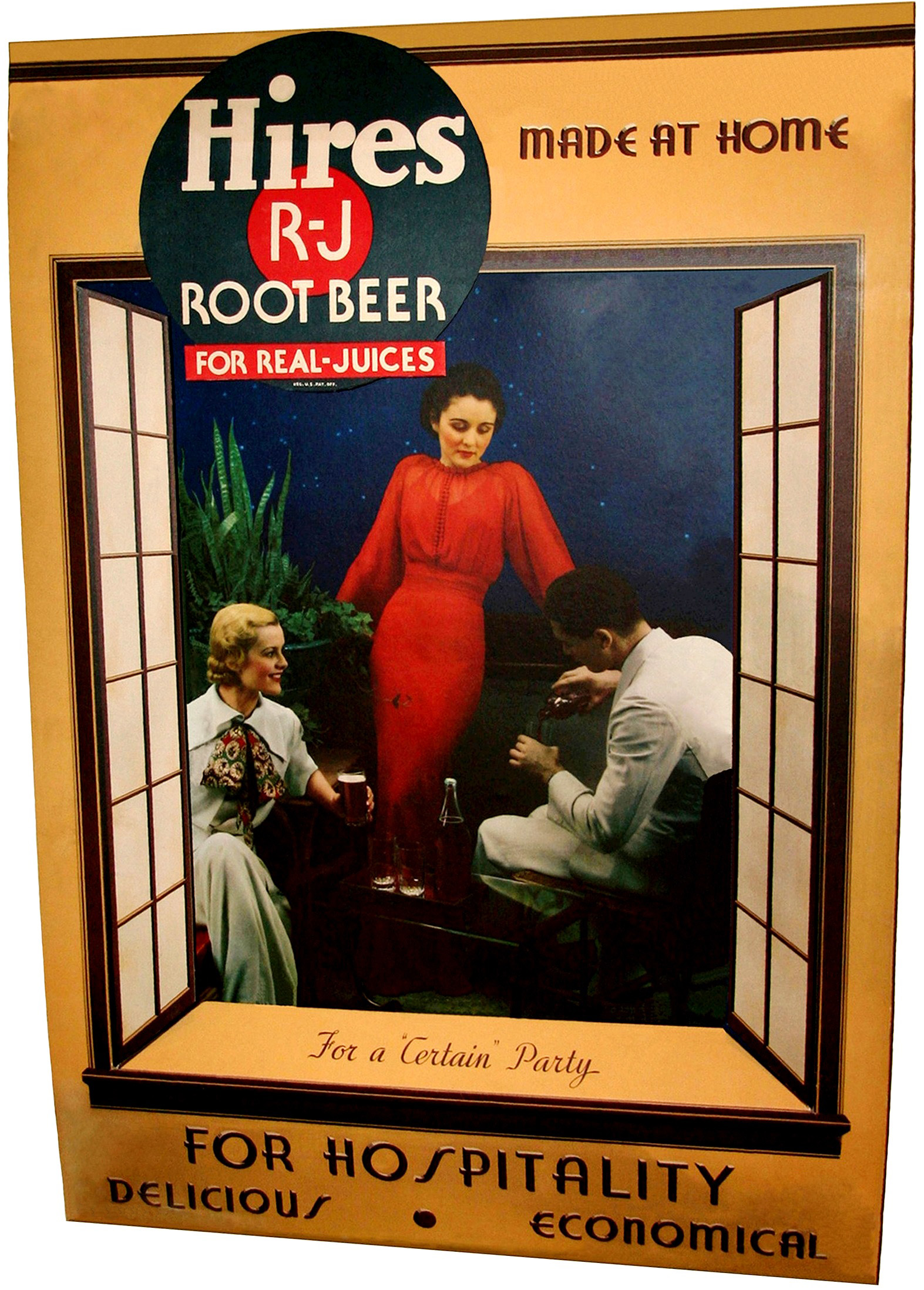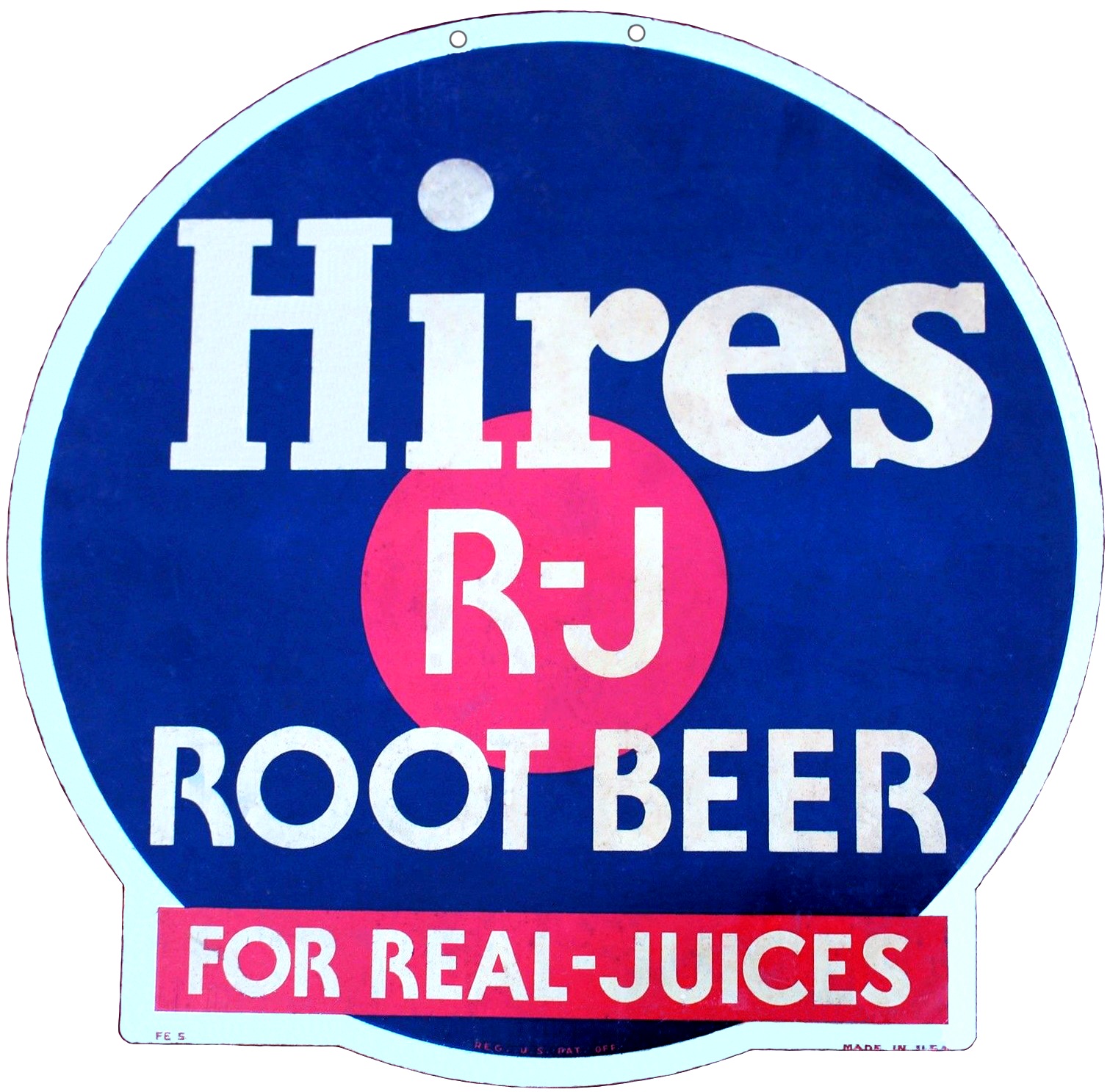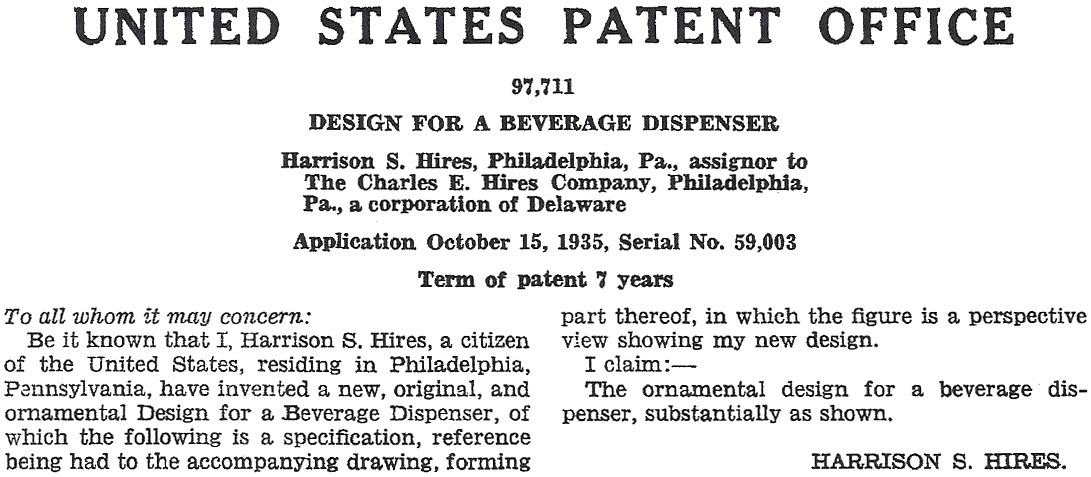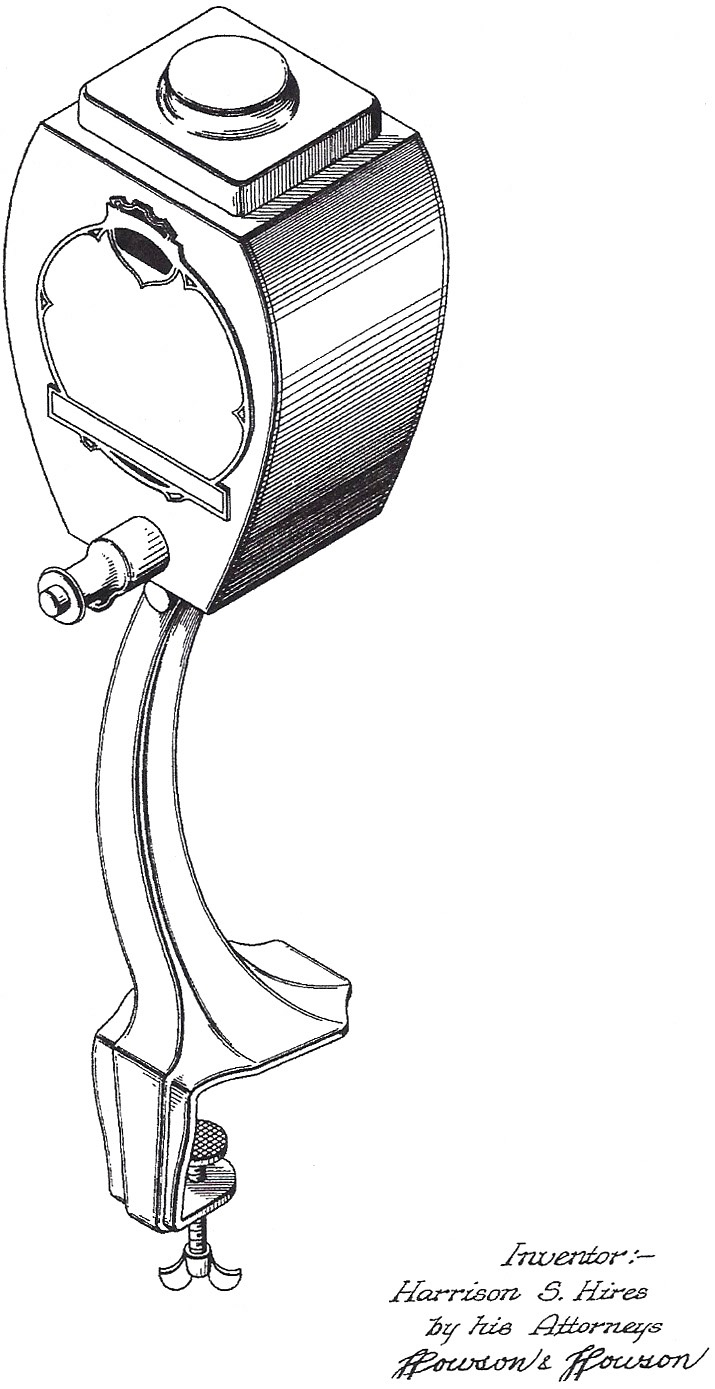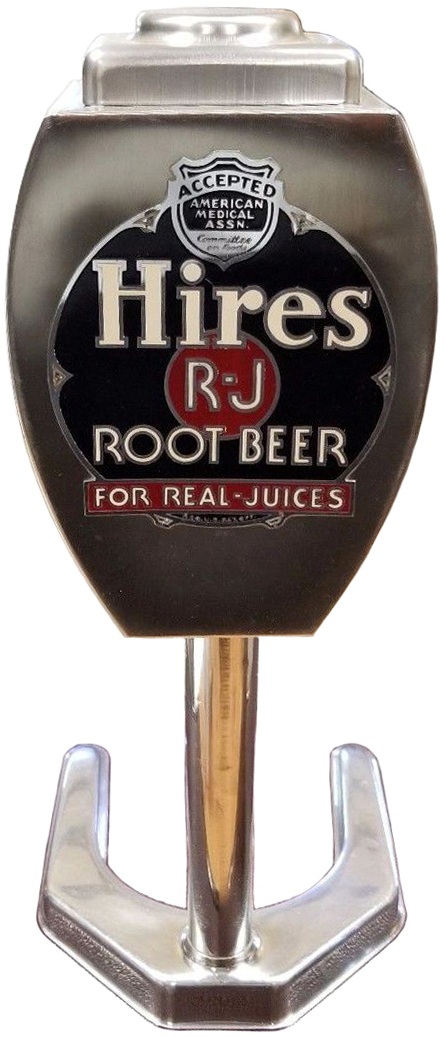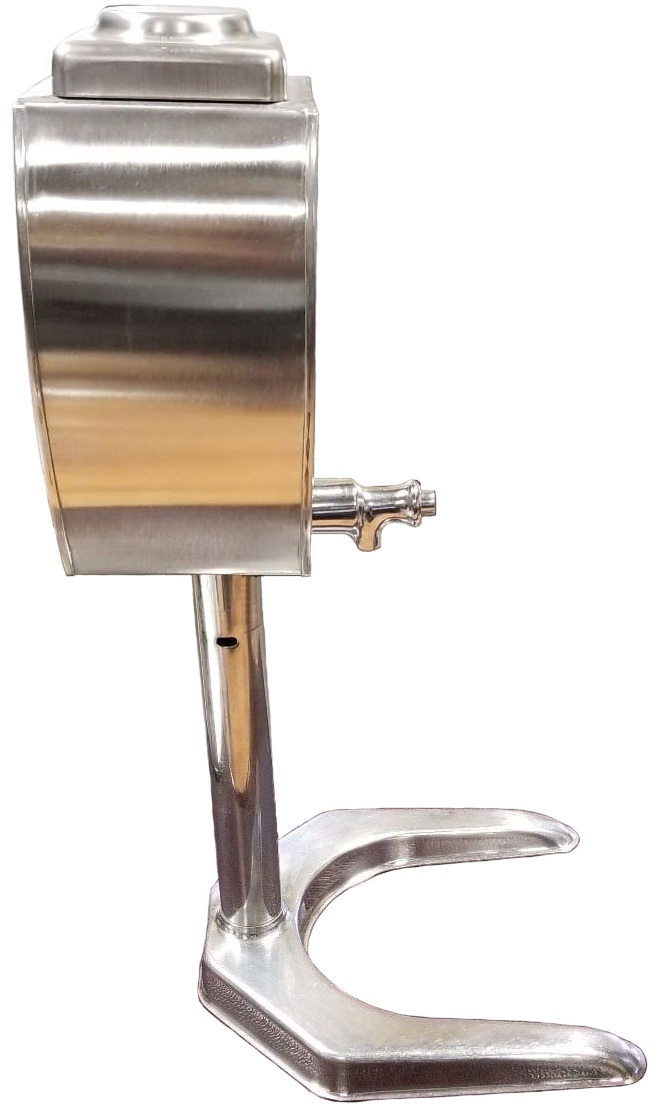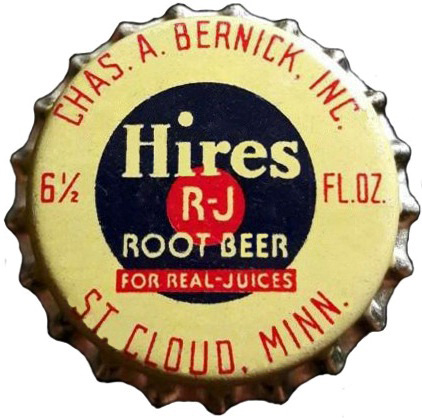1935
IT HAPPENED IN…1935
Troubled times pulled people to Prohibition and
many counties were voted dry again.
Alcoholics Anonymous was organized in New York City.
The Works Progress Administration was
established.
President Roosevelt signed the Social Security
Act to pay old-age benefits.
An infantile paralysis (polio) epidemic renewed
interest in combating the disease, led by President Franklin D.
Roosevelt who had been stricken with polio in 1921.
Newly introduced products and inventions included
the Richter scale, portable electronic hearing aids, Monopoly board
game, polyethylene, ballpoint pens, and trampolines.
The Nehi Corporation introduced Royal Crown Cola.
6,092 U.S. soft drink bottling plants were in
operation. Per capita
consumption was 37.1 bottles.
The paper labels used for mailing free samples of Hires Extracts were updated with the Hires R-J Root Beer For Real-Juices logo in 1935.
(Figure 1935-01, cardboard
mailing tube for a free sample, three views)
Each sample carton of Hires Root Beer, Ginger Beer, Birch Beer, and Kulah Ade extract contained a three ounce bottle plus an 8.0" x 12.0" paper insert explaining "HOW TO MAKE Delicious, wholesome Hires Beverages." The inserts were folded into 3.0" x 4.0" booklets with eight full-color outside pages, and eight black-and-white inside pages. Here are enlarged copies of the outside and inside pages:
(Figure 1935-01.5, Hires
Extract paper insert, outside, page 1)
(Figure 1935-01.5, Hires
Extract paper insert, outside, page 2)
(Figure 1935-01.5, Hires
Extract paper insert, outside, page 3)
(Figure 1935-01.5, Hires
Extract paper insert, outside, page 4)
(Figure 1935-01.5, Hires
Extract paper insert, outside, pages 5 and 6)
(Figure 1935-01.5, Hires
Extract paper insert, outside, page 7)
(Figure 1935-01.5, Hires
Extract paper insert, outside, page 8)
(Figure 1935-01.5, Hires
Extract paper insert, inside, page 1)
(Figure 1935-01.5, Hires
Extract paper insert, inside, page 2)
(Figure 1935-01.5, Hires
Extract paper insert, inside, page 3)
(Figure 1935-01.5, Hires
Extract paper insert, inside, page 4)
Note the next panel's mention that "Many families have equipment used before Repeal for making other beverages. This can now be used for healthful and delicious Hires Root Beer, Hires Ginger Beer, Hires Birch Beer." It appears Hires may have been target marketing potential customers who survived Prohibition by doing some home brewing until it was repealed effective December 5, 1933.
(Figure 1935-01.5, Hires
Extract paper insert, inside, page 5)
(Figure 1935-01.5, Hires
Extract paper insert, inside, page 6, upper)
(Figure 1935-01.5, Hires
Extract paper insert, inside, page 6, lower)
(Figure 1935-01.5, Hires
Extract paper insert, inside, page 7)
(Figure 1935-01.5, Hires
Extract paper insert, intside, page 8)
This metal rack used for dispensing cartons of Hires Extract has been filled with newer cartons from 1939.
(Figure 1935-02, metal rack for dispensing
Hires Extract, 19.0” x 5.0”)
(Figure 1935-03,
Collier’s,
May 4, 1935)
This pocket-sized, folding,
Precious Health brochure
features full-color photos and notes “Hires R-J Root Beer, famous for
over 60 years…and approved by Good Housekeeping Bureau.” "Over 60
years" would be pre-1875; yet another copywriter exaggeration.
(Figure
1935-04,
Precious Health brochure, back and front)
(Figure
1935-04,
Precious Health brochure, inside page)
This A New Idea In Good Taste
brochure promoted "4 Refreshing, Instant Ades," including Hires Root
Beer, Ginger Beer, and Birch Beer, and introduced Kulah Ade, a new
extract “with the tantalizing tang of tropical flavors.”
(Figure
1935-05, A New
Idea In Good Taste brochure, back and front)
(Figure
1935-05, A New
Idea In Good Taste brochure, inside)
(Figure 1935-06, Hires Root
Beer, Ginger Beer, and Birch Beer Extract cartons)
(Figure 1935-07, Hires Kulah
Ade Extract carton)
During the 1930s Chevrolet published
Fleet Users Experience
booklets, “A series of actual experiences as told by some of America’s
largest automobile fleet users.”
The June, 1935 issue featured “The Experience of The Charles E.
Hires Company, Philadelphia, PA.”
Here’s the first page’s bold headline and a Hires sign image
(Figure 1933-11), plus the remaining content:
1,200,000,000 GLASSES YEARLY!
Back in the early ‘70s, long before automotive
transportation, a self-starting young pharmacist conceived the idea for
a product that was destined to be the vehicle of his success.
With his idea foremost, he placed courageous hands to the wheel
of enterprise and accelerated it along the road of progress.
The dust of covered wagons still lay in rutted trails
when this practicing visionary, Charles E. Hires, while vacationing,
drank a cup of tea brewed from sweetfern, sassafras and teaberries by a
New Jersey farmwife. He had
already made a special study of the medicinal and food values of roots,
barks, plants and herbs – was already manufacturing – selling to other
druggists flavoring extracts.
To him this simple hospitable offering was not just a pleasing
cup of tea but a marketable possibility.
He consulted physicians and food specialists – experimented until
he was satisfied that a healthful, pleasing drink could be made.
He was ready – and to the public was given – HIRES ROOT BEER.
Today its motorized ambassadors are ‘fleet’ traveled
over the country’s broad highways – contacting distribution at a speed
that would have seemed no less than a miracle – when the Pony Express
Rider was the ultimate of fast travel.
Those were the days when merchandising too, moved at a snail’s
pace, but a web of rails was spreading the country – the cry – ‘Westward
HO!’ re-echoed – was heard by the pathfinders of distribution.
It was then that this pioneer of modern marketing commenced to
beat a path through the wilderness of advertising – to help set the pace
– smooth rough trails – establish new methods.
In 1877 his first
advertisements appeared in the Philadelphia newspapers – five-line
single-column notices.
Throughout the ‘80s larger space was used but still closely
Bible-like typed.
In 1889 he hewed the way through publishers’ intolerance –
persuaded Mr. Childs, Philadelphia
Public Ledger’s editor, to
run full-page advertising.
The effect was sensational.
Full-page space in other cities in women’s magazines and farm
papers followed and each year almost without exception, the advertising
increased. Charles E. Hires
has seen his business grow from a ‘cup of tea’ – 115,200 glasses the
first year – to over 1,200,000,000 glasses yearly.
Because of vision, a product was created; because of
ideals it endured through the years surmounting the obstacles of wars,
national, industrial and financial crises.
Because of a cup of tea that stimulated the imagination of a
young pharmacist, thousands of dollars worth of ingredients are shipped
yearly from foreign ports to Philadelphia.
From Honduras, sarsaparilla; Jamaica, ginger; Mexico, vanilla
beans; Brazil, yerba mate; Italy, juniper berries; Germany, dog grass;
Spain, licorice; India, chiretta and spikenard; from Cuba from Hires’
own plantation, cane sugar – and from this Country, sassafras,
pipsissewa and wintergreen.
The best the world has to offer.
From the simple percolation of a New Jersey housewife
have developed the extensive and careful percolations that enable the
consumer today to enjoy a beverage that retains the delicate flavor of
its natural ingredients, real juices – a beverage that neither finds it
necessary nor tolerates artificial colors or flavors – a beverage that
has the full approval of The American Medical Association, Child Life,
Food Research Laboratories, Inc., Good Housekeeping Bureau of Foods,
Sanitation and Health, Physical Culture Institute of Nutrition, and the
Home Makers Educational Service.
Truly industrial romance -- in it the sinew and
virility of true American achievement – the same fortitude that has
given us automotive progress, the hardiness that has carried on through
a tangle of trails beset with difficulties.
Many have sought, many have traveled beyond their strength – many
have lightened the load – discarded ideals – they fell beside the trail.
But the hard plodded on – endured!
Fleet Operation is Highly Efficient to Reach Three Large Markets
The Charles E. Hires Company now manufactures and
sells through three different markets.
The first field of activity deals with the pioneer branch of the
business – the manufacture of Hires Root Beer Extract for home-making,
and the manufacture of extracts in two other flavors – Hires Ginger Beer
and Hires Birch Beer – also Hires Kulah Ade.
The second market is established through the sale of Hires Root
Beer to soda dispensing outlets such as drug stores, confectioneries,
all variety of merchandise stores, amusement parks, etc.
The third market consists of bottlers of carbonated beverages who
are licensed to bottle Hires Root Beer.
These companies make Hires Root Beer from the Hires Bottlers’
Solution. They supply their
own customers among stores and refreshment stands in their respective
localities.
A high order of management efficiency is brought to
bear to operate the continent-wide activities of the Hires organization.
The Hires business ‘goes on forever’ and its stock in trade is
units of comparatively small size.
Service is therefore the keystone of the Hires business structure
- since public preference long since has established the popularity of
the original flavor formulae.
To handle its national service plan, The Charles E.
Hires Company employs a fleet of Chevrolet Sedan Deliveries and Half-Ton
Panel Trucks. These units
operate out of the following points of distribution: Calif. – Glendale,
Long Beach, Oakland, Sacramento, San Francisco.
Colo. – Denver.
Conn. – West Haven.
Washington, D.C. Fla. –
Jacksonville, Miami. Ill. –
Chicago, Downers Grove, Oak Park, Peoria.
Ind. – Indianapolis.
Iowa – Davenport, Des Moines.
La. – New Orleans.
Maine – Woodfords. Md. –
Baltimore. Mich. – Royal
Oak. Minn. – Minneapolis.
Mo. – Kansas City, St. Louis.
Nebr. – Omaha. N. J.
– Belleville, East Orange.
N. Y. – Brooklyn, Buffalo, Flushing, L.I., New York, Syracuse.
Ohio – Cuyahoga Falls, Cincinnati, Cleveland, Columbus, Toledo.
Okla. – Tulsa. Ore.
– Portland. Pa. –
Harrisburg, Philadelphia, McKees Rocks, Pittsburgh, Scranton.
R. I. – Providence.
Mass. – Arlington, Dorchester, Hingham Centre Springfield.
Canada – Montreal, Toronto.
Tex. – Dallas, Houston.
Wash. – Seattle.
Wis. – Milwaukee.
Fleet Experience of The Charles E.
Hires Company
There are 57 Chevrolet Sedan Delivery models and 10
Chevrolet Half-Ton Panel trucks in the fleet of the Hires national
organization. All of the
Sedan Deliveries and most of the Half-Ton Panel Trucks are used by Hires
sales representatives throughout the country to promote dealer display
advertising and to carry samples of all products being sold by the
company.
Advertising is one of the vital activities in the Hires organization. Since its inception the company has pioneered the use of large advertisements in newspapers and has originated many effective campaigns having to do with stimulation at the point-of-sale.
Millions of printed and lithographed pieces of advertising are supplied to dealers each year. In this connection, the Hires organization does a thorough job by counseling with the dealer and arranging his store displays of advertising material. As a result, the Hires vehicles are constantly on duty.
Mechanical supervision of the Chevrolet fleet is
handled in two ways. In
Philadelphia, The Charles E. Hires Company maintains a repair shop of
its own. But in all other
cities the cars are serviced by Authorized Chevrolet Dealers, according
to the instructions of the salesman operating the car or of the district
sales manager by whom the salesman is employed.
Operating cost and maintenance cost are computed and
supervised by means of charge arrangements and through the salesmen’s
weekly expense accounts.
Authorized Hires drivers may call at any of the service stations in the
United States operated by two of the large tired manufacturers and
several of the large oil companies, and charge supplies to The Charles
E. Hires Company. The
expense connected with each car is tabulated separately from these
invoices. Other expenses
incurred by the drivers are included on their weekly expense accounts
and posted to the account of the respective vehicle.
It is Hires practice to charge
all expenses to the record of operating cost.
This list of expense items includes insurance, licenses, storage
and garaging, washing, oil and gasoline, greasing, tires, repairs and
depreciation. Depreciation,
which is included in cost recapitulation, is charged off at the rate of
33 1/3 percent per annum.
Insurance coverage carried on
the vehicles consists of public liability protection in limits of
$100,000/100,000; property damage protection in limits of $5,000; fire
and theft. Collision
insurance is not carried.
The washing policy throughout the country calls for
washing cars at least once every ten days.
In Philadelphia, cars are washed once a week and wax-polished
every two weeks.
There is no rule regarding storage and garaging of
vehicles due to the different conditions under which vehicles operate in
the United States. Largely,
though, the Chevrolets are stored in public garages.
To some extent, Hires representatives keep their units in their
home garages.
Replacement of vehicles is made
according to the condition of the individual unit.
This is determined by studying the question of repair expense,
rather than by using a time or mileage gauge.
If circumstances indicate a major repair job necessary, it is
generally more economical to trade the car or truck on a new vehicle,
particularly if new tires and other items are required at the same time.
Most of the trade-ins have been made at a mileage upwards of
40,000. Some units have
operated as high as 65,000 miles before being traded.
The length of time before trading also varies,
averaging two to two and a half years.
Under normal operating conditions, the units travel 40,000 to
50,000 miles in two to two and a half years.
Operating Cost of Chevrolet Fleet of 57 Sedan Deliveries
THE CHARLES E. HIRES COMPANY
Description
Cost per
Mile
Gasoline, Oil and Grease . . . . . . . . . . . . . . . . . . . . . . . .
. .0134071
Depreciation . . . . . . . . . . . . . . . . . . . . . . . . . . . . . .
. . . . . .0109857
Storage . . . . . . . . . . . . . . . . . . . . . . . . . . . . . . . .
. . . . . . . . .0037512
Repairs . . . . . . . . . . . . . . . . . . . . . . . . . . . . . . . .
. . . . . . . . .0020979
Tires and Tubes . . . . . . . . . . . . . . . . . . . . . . . . . . . .
. . . . .0015129
Insurance . . . . . . . . . . . . . . . . . . . . . . . . . . . . . . .
. . . . . . .0014066
Licenses . . . . . . . . . . . . . . . . . . . . . . . . . . . . . . . .
. . . . . . .0013556
Washing . . . . . . . . . . . . . . . . . . . . . . . . . . . . . . . .
. . . . . . .0008198
Miscellaneous . . . . . . . . . . . . . . . . . . . . . . . . . . . . .
. . . . .0006827
Bridge Toll and Ferry Charges . . . . . . . . . . . . . . . . . . .
.0003691
.0363886
Total mileage on 57 Sedan Deliveries - 1,402,089.
Hires R-J Root Beer concentrate was also distributed
in rectangular, quart, amber bottles with foil labels.
The shoulder is embossed “SHAKE WELL” and the side panel is
embossed “ONE QUART” below the label.
The pictured example still has its original cap and some of the
ingredients.
(Figure 1935-08, amber, quart, concentrate bottle, 10.0” tall)
(Figure 1935-09, tin sign, 10.0” x 28.0”)
(Figure 1935-10, 3-D tin sign, 13.5” diameter)
(Figure 1935-11, embossed tin
sign, 10.0” x 28.0”)
(Figure 1935-11.5, Liberty,
June 22, 1935)
The format and content of this advertisement is similar to the one placed in the May 4, 1935 issue of Collier’s.
(Figure 1935-12,
Life,
July 6, 1935)
It appears the same designer also produced this magazine advertisement.
(Figure 1935-12.5,
magazine advertisement)
(Figure 1935-13, porcelain on metal sign, 28.0” x 11.0”)
(Figure 1935-14, double-sided, flanged, wall-mounted, steel sign, 16.0” x 14.0”)
The Queen City Bottling Company in Cincinnati,Ohio affixed paper Hires body and neck labels to their proprietary company bottles prior to Hires' introduction of a standard, "ornamental design" bottle for use by all Hires bottlers. Note the Good Housekeeping and American Medical Association logos on the neck label. The embossing high on both sides of this emerald green bottle's neck is Queen City's "QCBCo" monogram.
(Figure 1935-14.5, paper-labeled bottle)
The same paper body and neck labels (without a bottler's name and location) are pictured on the bottle illustrated in the following sign. Hires' patent filing for this bottle design was granted in 1936 (see Figure 1936-02).
(Figure 1935-15, die-cut,
cardboard sign, 10.0” x 9.0”)
A similar sign was also produced picturing an etched Hires R-J glass.
(Figure 1935-15.5, die-cut,
cardboard sign, 10.0” x 9.0”)
This gold foil, die-cut, cardboard restaurant menu display holder was a convenient method restaurant operators used to update and display menu choices and prices (note that the menu sheets attached to this example weren't produced until 1949).
(Figure 1935-16, restaurant
menu display holder, 17.0” x 36.0”)
Here's an example of a 1935 paper menu sheet used with the restaurant menu display holder illustrated as Figure 1935.16. Check out the Depression era prices!
(Figure 1935-16.5, paper
menu sheet, 5.5” x 8.5”)
Here's another example produced by a restaurant using the same paper menu sheet.
(Figure 1935-16.6, paper
menu sheet, 5.5” x 8.5”)
The “windows” and “sill” on this die-cut, cardboard,
counter or window display fold inward, with tabs that fit into slots
producing a three-dimensional view of the party-goers enjoying Hires Root Beer.
(Figure 1935-17, counter or
window display, courtesy of the Wong collection)
(Figure
1935-18, tin sign, 10.0” diameter)
This heavy paper six-pack carrier with handles had a capacity of six 12
ounce bottles. Note the
lack of a pre-printed price and/or reference to a deposit on the
bottles.
(Figure 1935-19, heavy paper,
six-pack carrier, 8.5” tall x 7.75” wide)
Harrison S. Hires submitted received U.S. Patent # 97,711 December 3,
1935 for his “new, original, and ornamental Design for a Beverage
Dispenser.”
(Figure 1935-20, design for a
beverage dispenser, description)
(Figure 1935-20, design for a
beverage dispenser, illustration)
Here are customer and side views of the new dispenser designed by Harrison S. Hires. The patent design illustration includes a sturdy arm with an integrated base clamp for attachment to the edge of a counter. The example pictured below has a stand with a u-shaped base so the dispenser could be placed as desired on a counter and easily moved. The dispenser is 18.5” tall, 6.0” wide, and 4.0” deep. The base of this stand is approximately 10.0” x 11.0”. This side view shows the push-button spigot. The syrup container has the identical Hires R-J ROOT BEER FOR REAL-JUICES signage on the front and back.
(Figure 1935-21, beverage
dispenser, customer view)
(Figure 1935-21, beverage
dispenser, side view)
The logo on the earliest R-J crown caps included "Hires" inside the circle, and the "FOR REAL-JUICES" slogan.
(Figure 1935-22, crown cap)

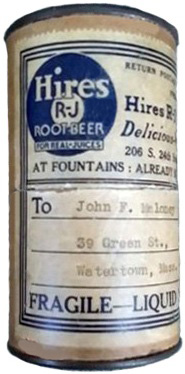
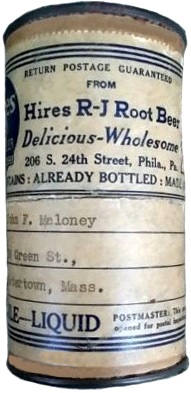
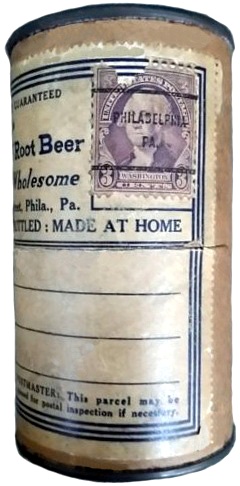
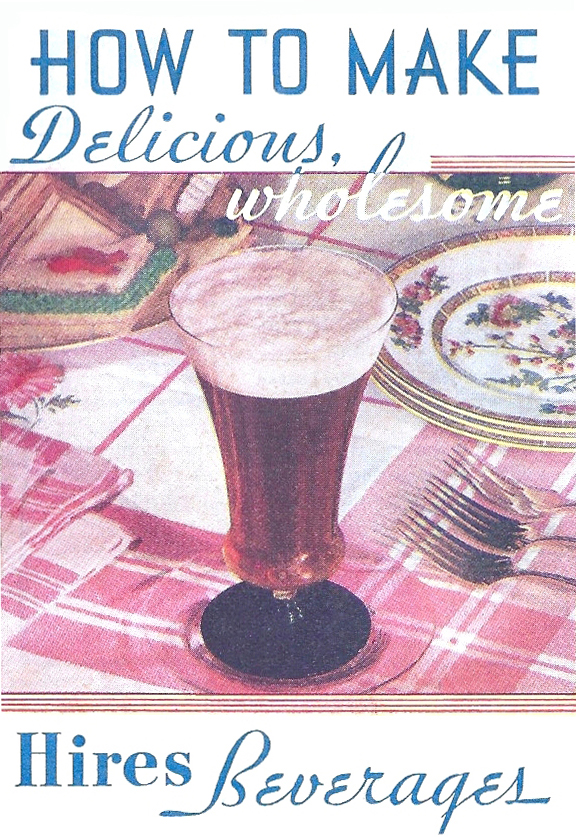
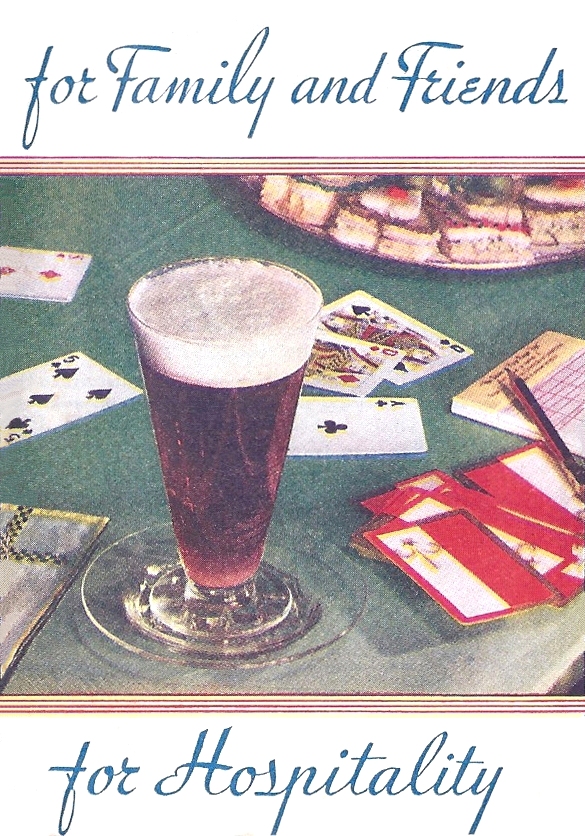
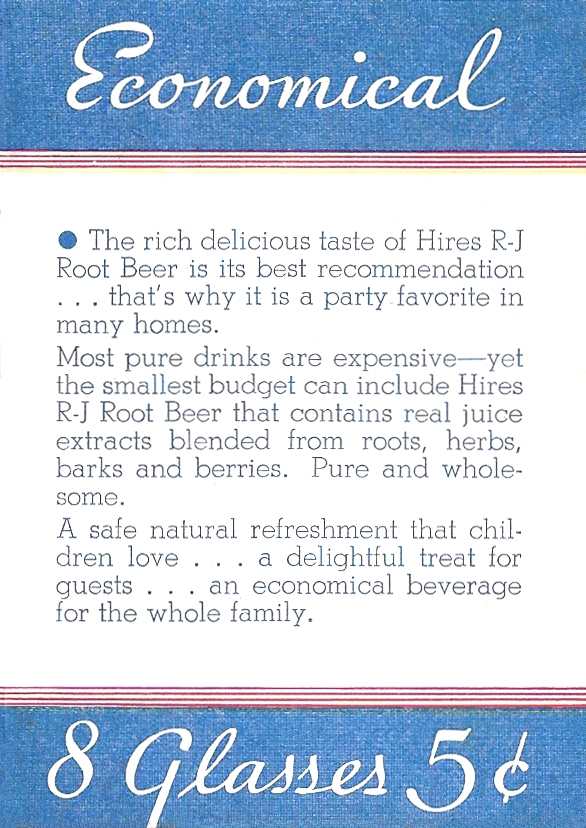
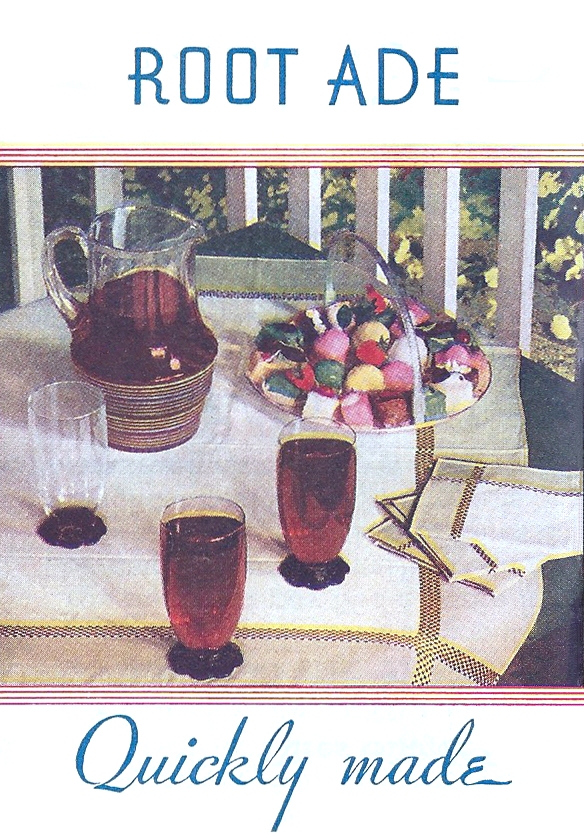
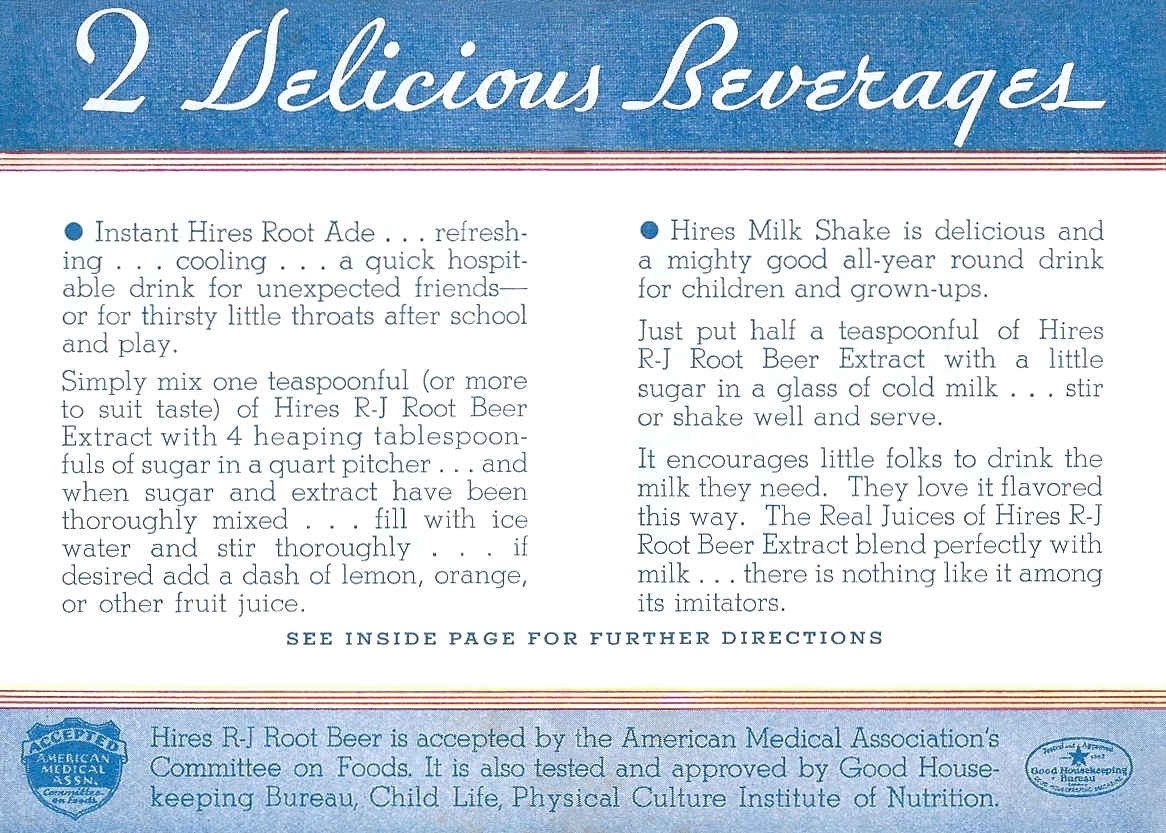

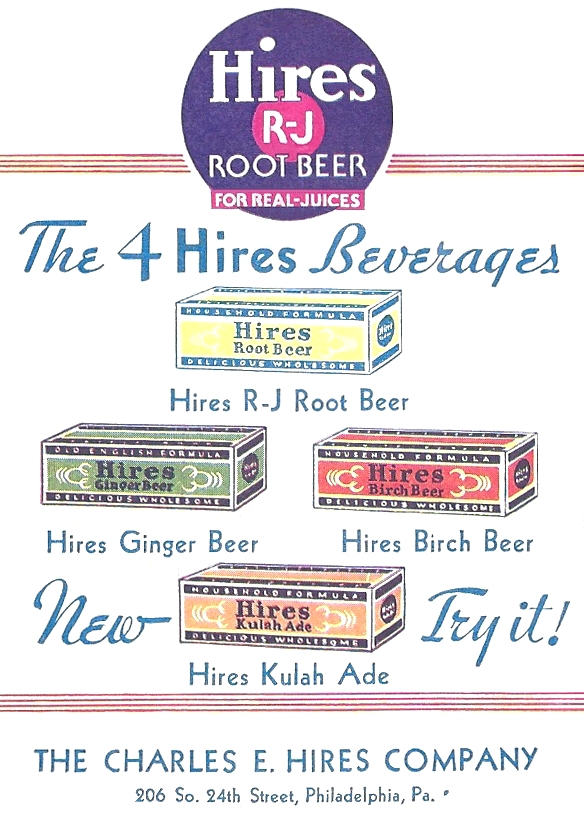

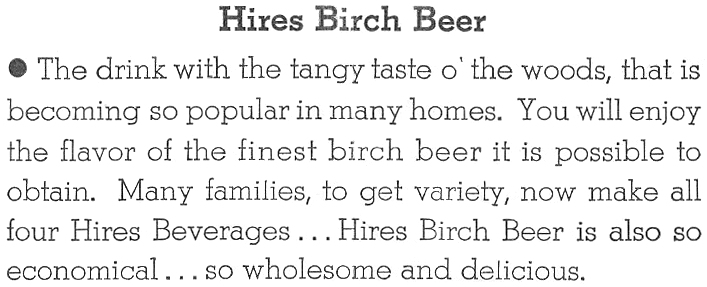
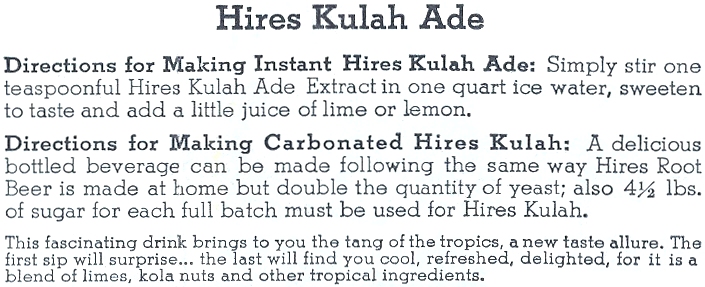

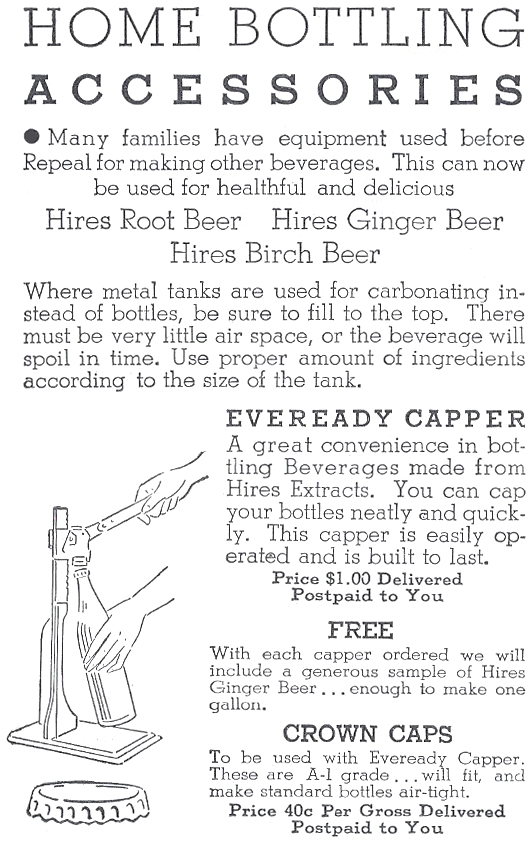


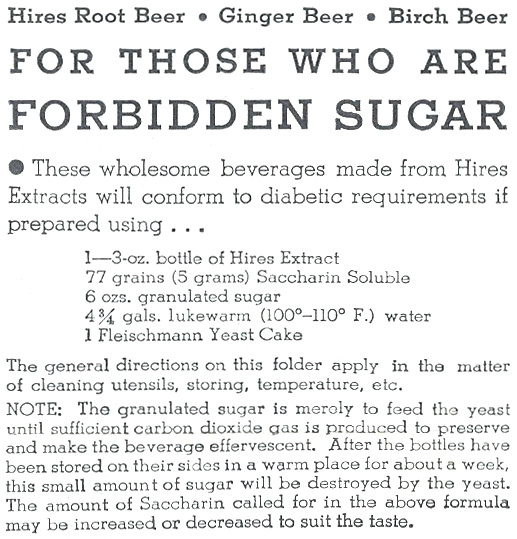
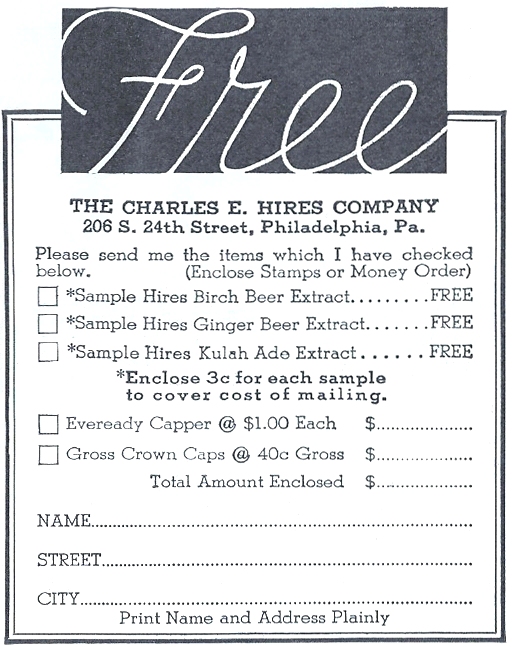



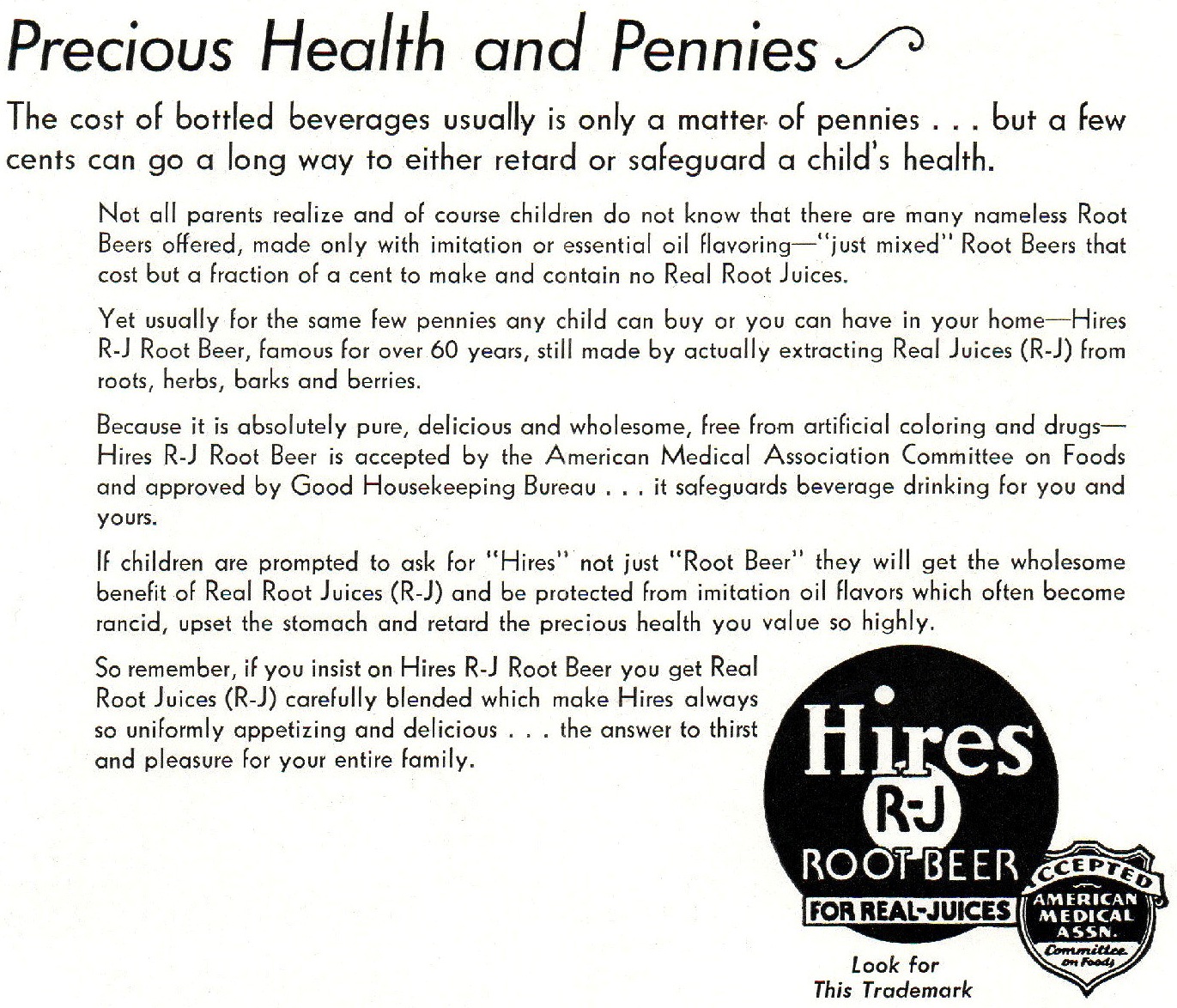
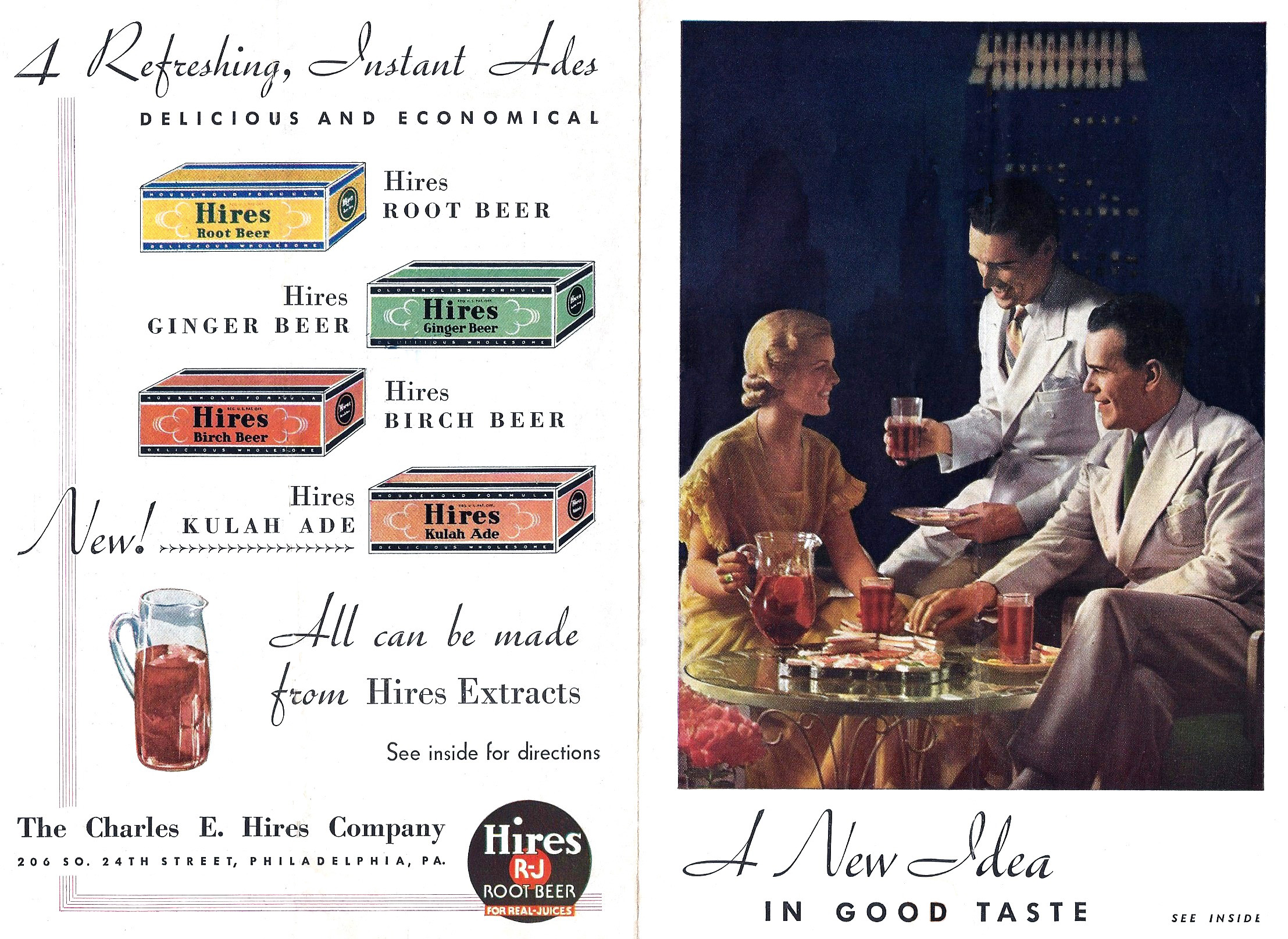




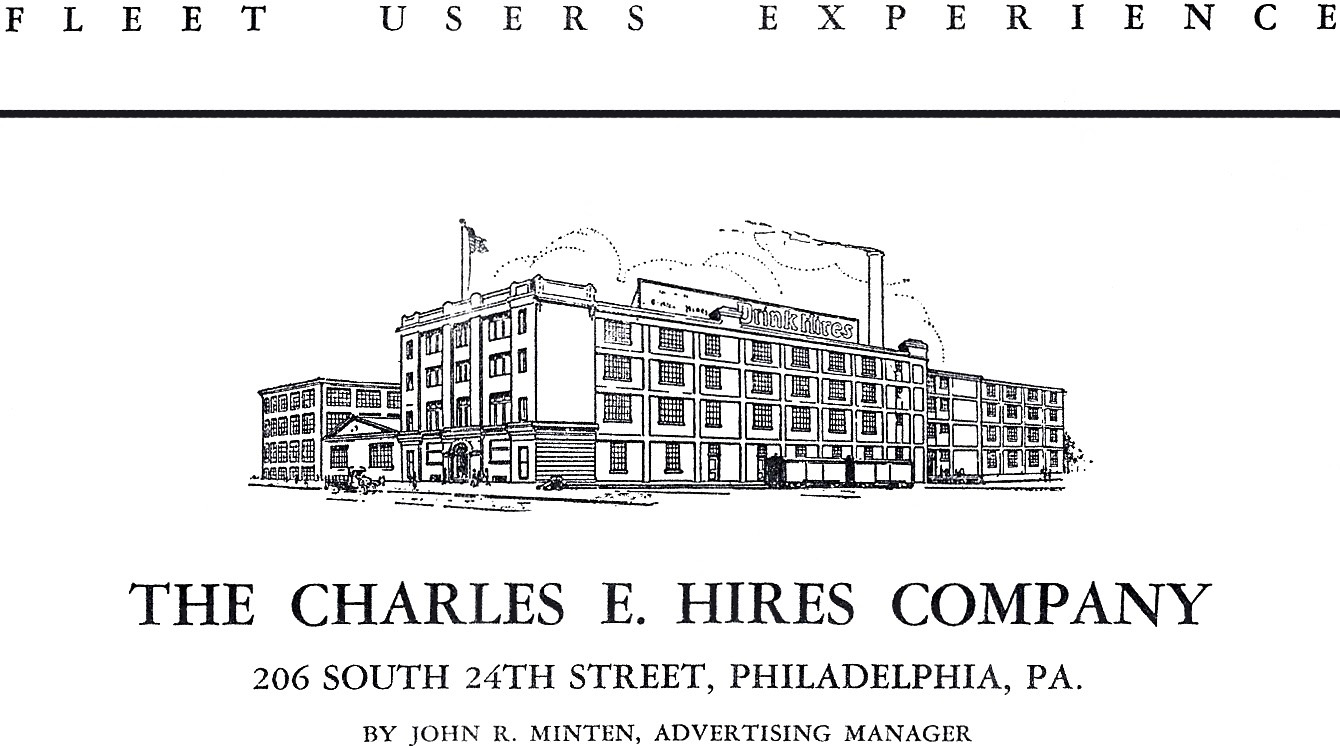
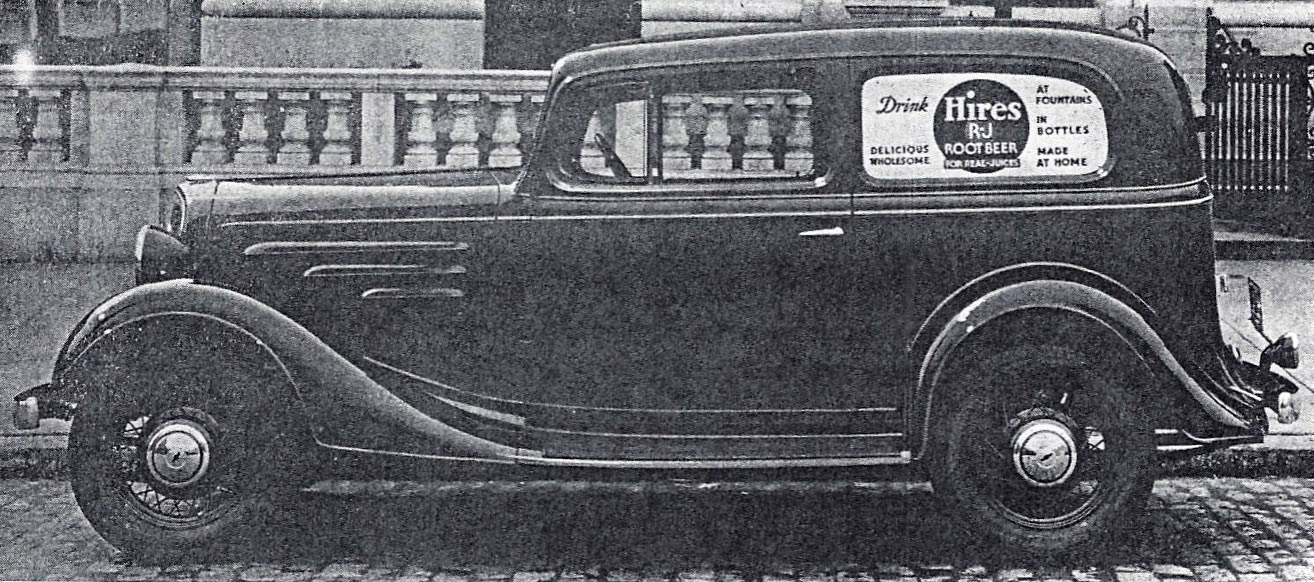
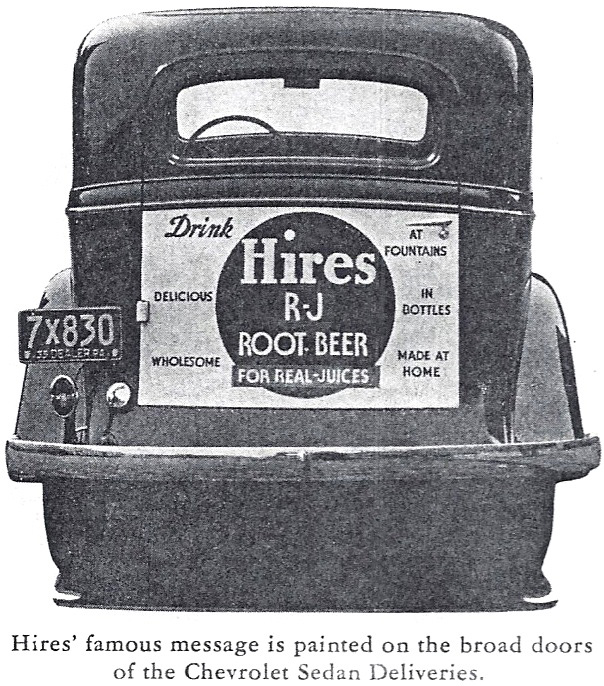
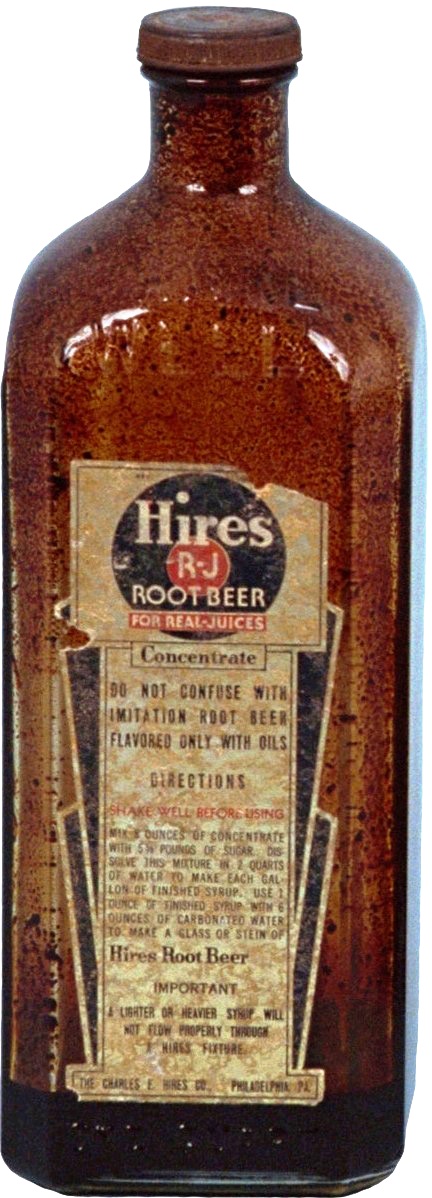
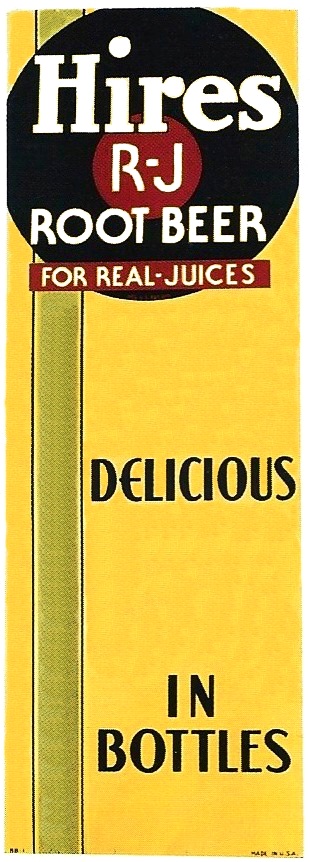
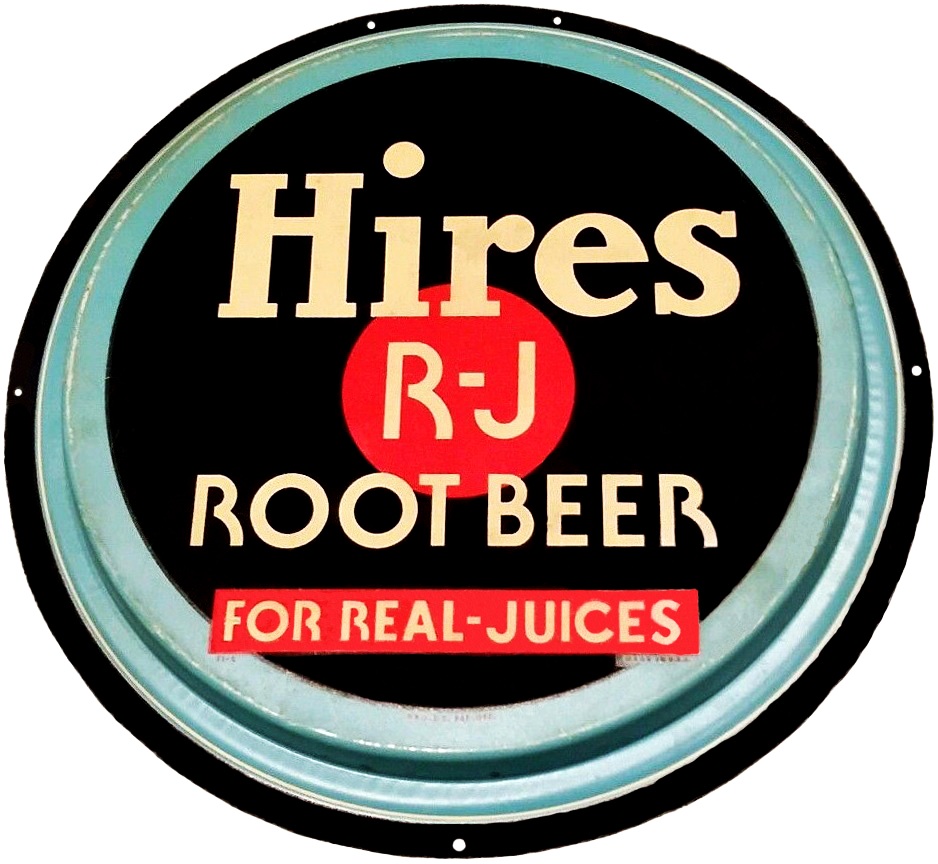
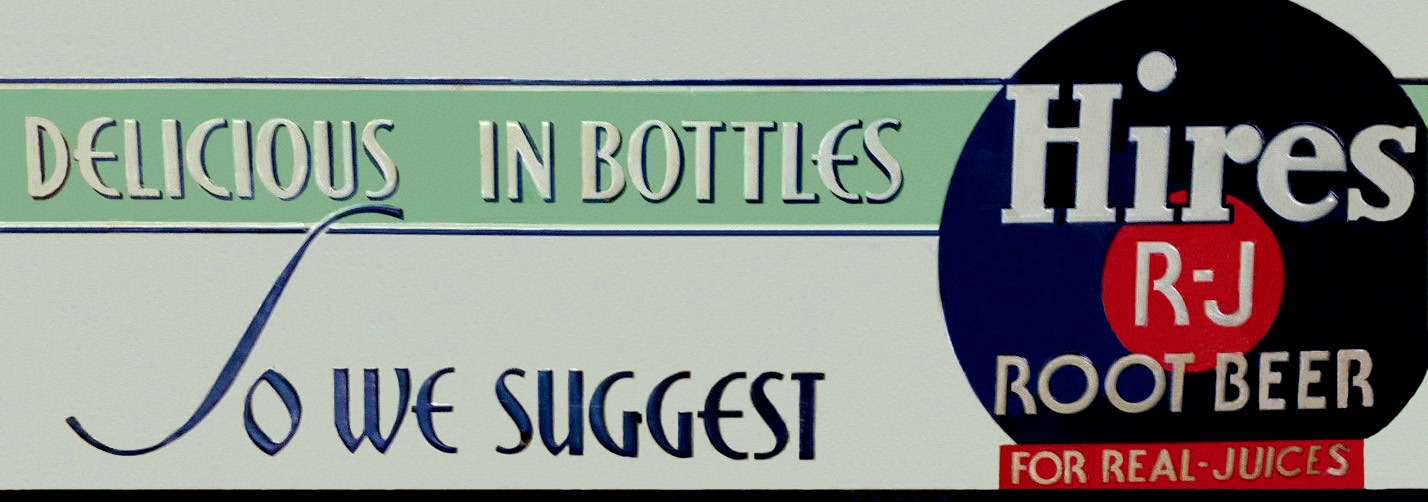



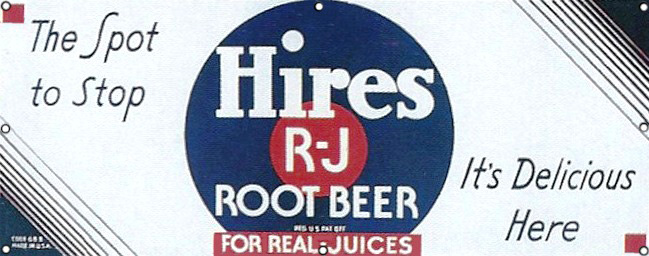

%20Root%20Beer%20For%20Real-Juices%20-%20paper%20body%20and%20neck%20labels%20-%20GH%20and%20AMA%20logos%20-%20embossed%20QCB%20neck%20monograms.jpg)
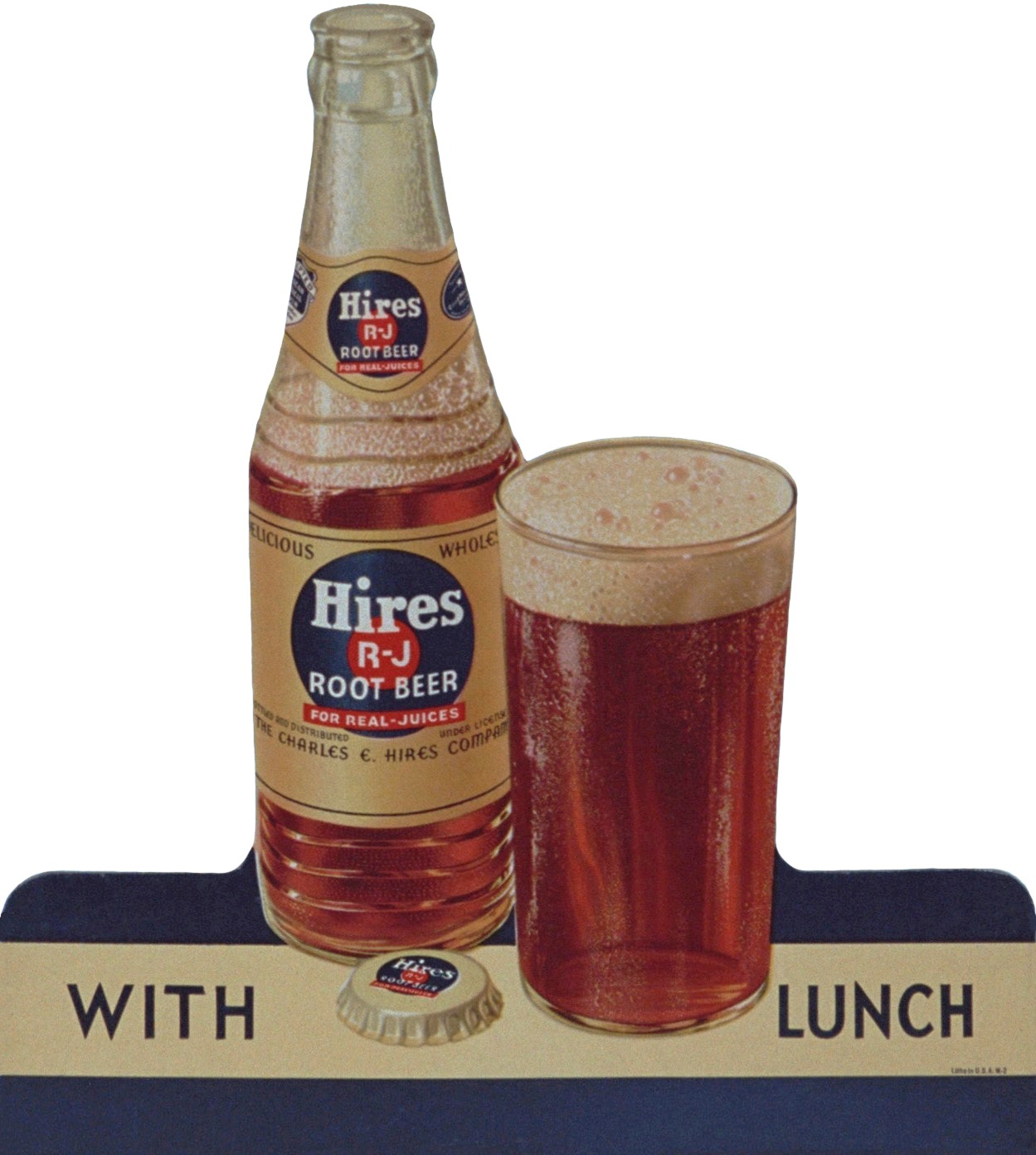
%20Root%20Beer%20with%20Real-Juices%20-%20Hires%20With%20Lunch%20etched%20glass%20-%20die-cut%20cardboard%20sign.jpg)
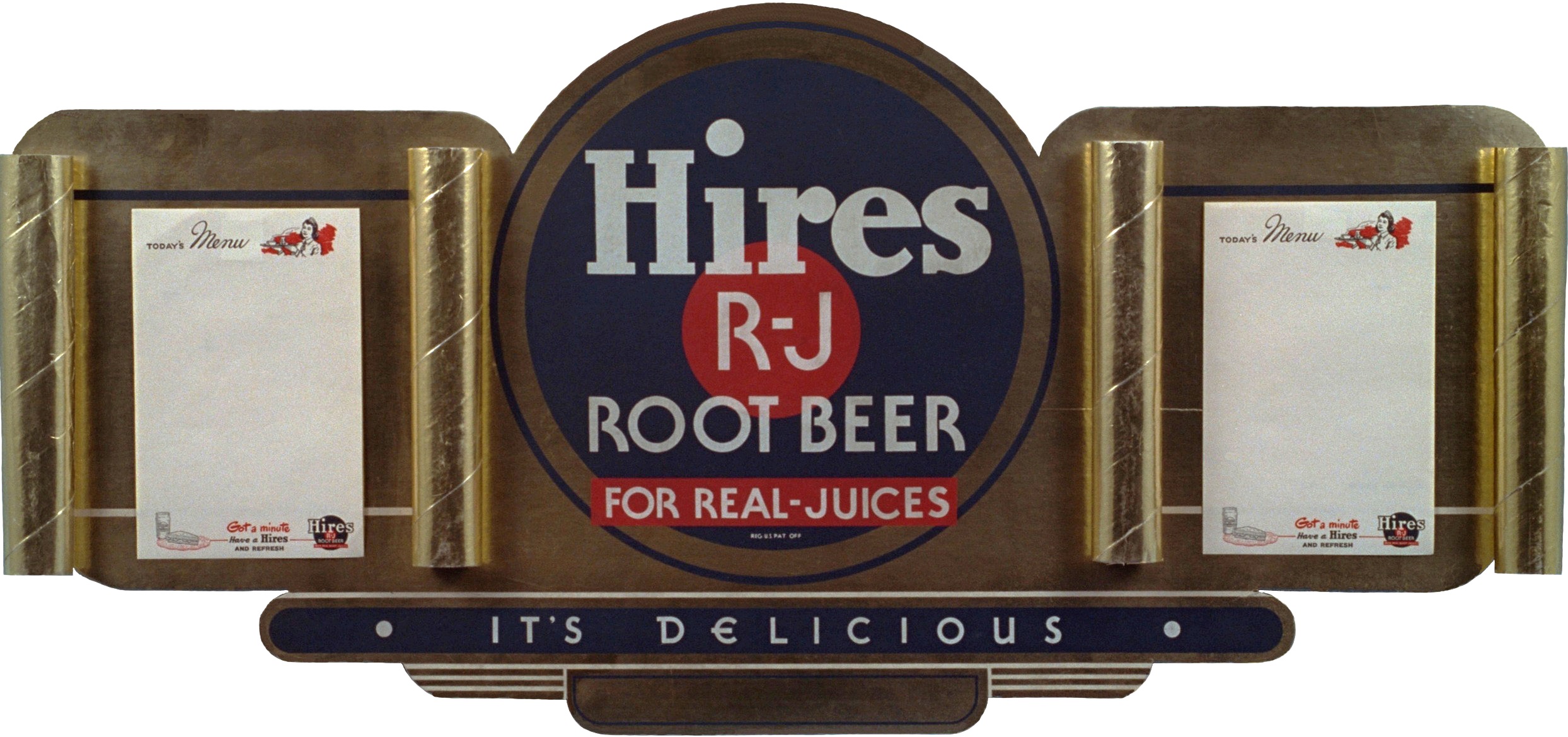
%20Root%20Beer%20For%20Real-Juices%20-%20Wholesome%20Delicious%20-%20sandwich%20menu%20sheet.jpg)
%20Root%20Beer%20For%20Real-Juices%20-%20Wholesome%20Delicious%20-%20sandwich%20menu%20sheet%205.5%20x%208.5.jpg)
